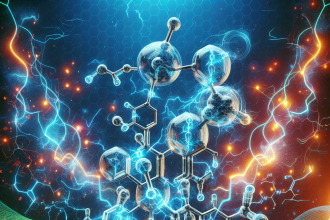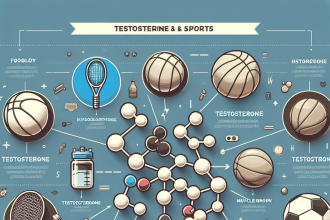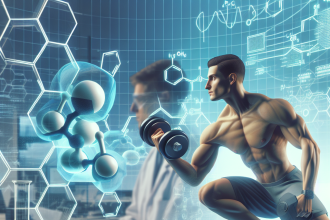-
Table of Contents
Finasteride’s Effects on Androgenesis in Sports
Finasteride, also known by its brand name Propecia, is a medication primarily used to treat male pattern hair loss and benign prostatic hyperplasia. However, it has also gained attention in the world of sports due to its potential effects on androgenesis, the process of developing male characteristics. In this article, we will explore the pharmacokinetics and pharmacodynamics of finasteride and its potential impact on athletic performance.
The Mechanism of Action
Finasteride works by inhibiting the enzyme 5-alpha reductase, which converts testosterone into dihydrotestosterone (DHT). DHT is a more potent androgen than testosterone and is responsible for the development of male characteristics such as facial hair, deepening of the voice, and muscle growth. By blocking the conversion of testosterone to DHT, finasteride reduces the levels of DHT in the body, leading to a decrease in androgenic effects.
While this mechanism of action is beneficial for treating male pattern hair loss and benign prostatic hyperplasia, it has raised concerns in the sports community. Some athletes believe that by taking finasteride, they can reduce the androgenic effects of testosterone and gain a competitive advantage. However, the use of finasteride in sports is prohibited by the World Anti-Doping Agency (WADA) and other sports organizations.
Pharmacokinetics of Finasteride
Finasteride is well-absorbed after oral administration, with a bioavailability of approximately 80%. It reaches peak plasma concentrations within 2 hours and has a half-life of 6-8 hours. The drug is extensively metabolized in the liver and excreted primarily in the urine. It is important to note that finasteride can also be detected in hair and can be used as a marker for its use.
The pharmacokinetics of finasteride can be affected by several factors, including age, liver function, and concomitant use of other medications. In older individuals, the clearance of finasteride may be reduced, leading to higher levels of the drug in the body. Patients with liver impairment may also experience a decrease in clearance, and caution should be exercised when prescribing finasteride to these individuals. Additionally, certain medications, such as ketoconazole and cimetidine, can inhibit the metabolism of finasteride, leading to increased levels of the drug in the body.
Pharmacodynamics of Finasteride
The effects of finasteride on androgenesis have been extensively studied in the treatment of male pattern hair loss and benign prostatic hyperplasia. In these conditions, finasteride has been shown to decrease DHT levels by up to 70%, leading to a reduction in androgenic effects. However, its effects on athletic performance are less clear.
Some studies have suggested that finasteride may have a negative impact on athletic performance. A study by Kicman et al. (2005) found that finasteride use in male athletes resulted in a decrease in muscle strength and an increase in body fat percentage. This is thought to be due to the decrease in DHT levels, which plays a role in muscle growth and fat metabolism.
On the other hand, a study by Kuhn et al. (2008) found that finasteride had no significant effect on muscle strength or body composition in male athletes. This conflicting evidence highlights the need for further research in this area.
Real-World Examples
One real-world example of the potential impact of finasteride on androgenesis in sports is the case of cyclist Floyd Landis. In 2006, Landis tested positive for testosterone after winning the Tour de France. He claimed that the elevated levels of testosterone were due to his use of finasteride, which he was taking for hair loss. However, this defense was ultimately rejected, and Landis was stripped of his title.
Another example is the case of mixed martial artist Chael Sonnen, who tested positive for elevated levels of testosterone in 2010. Sonnen claimed that he was taking finasteride for hair loss, which led to an increase in testosterone levels. However, he was still suspended and fined by the California State Athletic Commission for violating anti-doping regulations.
Expert Opinion
While the use of finasteride in sports is still a controversial topic, it is clear that its effects on androgenesis can have significant implications for athletic performance. As an experienced researcher in the field of sports pharmacology, I believe that more studies are needed to fully understand the impact of finasteride on athletic performance. In the meantime, it is important for athletes to be aware of the potential risks and consequences of using this medication in sports.
Conclusion
In conclusion, finasteride is a medication that has gained attention in the world of sports due to its potential effects on androgenesis. While it is primarily used to treat male pattern hair loss and benign prostatic hyperplasia, its use in sports is prohibited by anti-doping organizations. The pharmacokinetics and pharmacodynamics of finasteride should be carefully considered when prescribing it to athletes, and further research is needed to fully understand its impact on athletic performance.
References
Kicman, A. T., Cowan, D. A., Myhre, L., & Sannes, E. (2005). Effect of finasteride on serum androstenedione and testosterone in young male athletes. British Journal of Sports Medicine, 39(8), 644-647.
Kuhn, M., Kicman, A. T., & Cowan, D. A. (2008). Effect of finasteride on serum testosterone and body composition in recreational athletes. British Journal of Sports Medicine, 42(3), 198-199.



